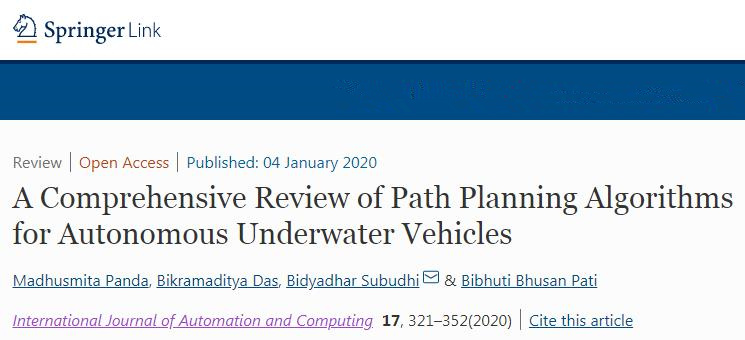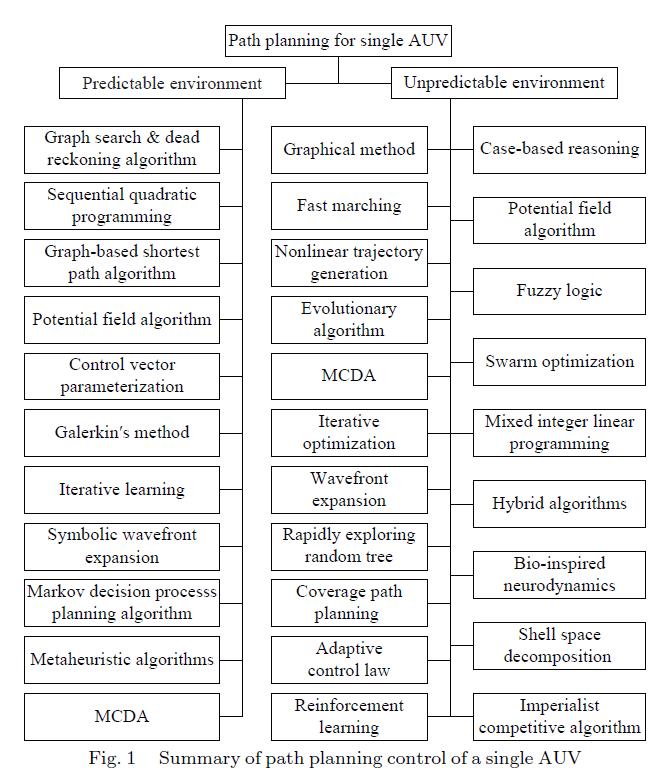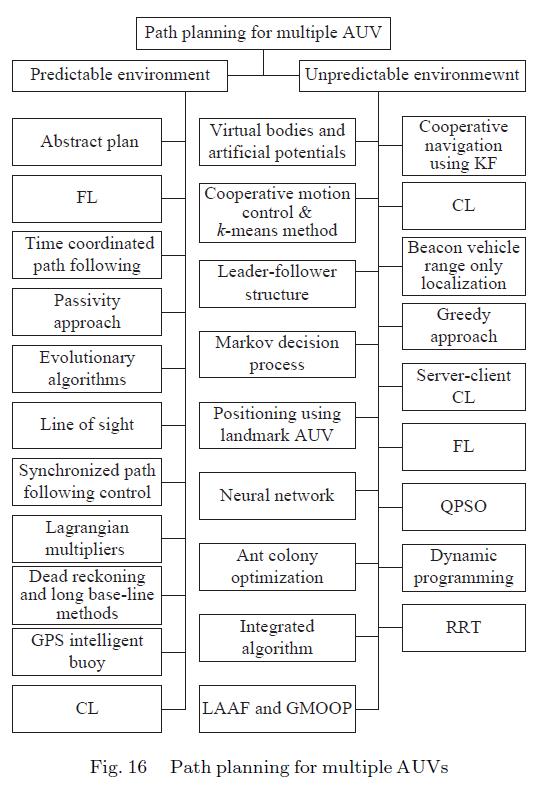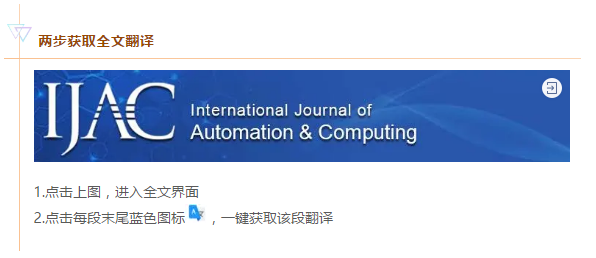博文
综述:自主式水下机器人的路径规划算法
|||
自主式水下机器人(AUV)是一种工作于水下、具有智能行为的作业机器人,其主要由自动驾驶、导航定位、自诊断和故障处理、测量设备和能源等组成,被广泛应用于军事和民用领域。本文旨在定性分析海洋环境对AUVs路径规划的影响。以可预测和不可预测的环境行为模型为参考,本文总结了应用于单AUV和多AUVs的路径规划算法,简要讨论了AUV路径规划中涉及的问题,从环境类型、生成路径类型、路径成本(path cost)和防撞特性(collision avoidance features)等方面对算法进行了比较,并讨论了各种方法的优缺点。

全文下载(开放获取)
https://link.springer.com/article/10.1007/s11633-019-1204-9

自主式水下机器人(Autonomous underwater vehicles, AUVs)是由“无人水下机器人”(unmanned underwater vehicles, UUVs)构成的一组水下系统(submerged systems)。无人水下机器人可分为自主式水下机器人和无人遥控潜水器(remotely operated vehicle, ROV)两类。无人潜水遥控器由地面控制站(surface control station)通过电缆(umbilical cord)或遥控装置(remote control)对其进行供能、完成操作。
自主式水下机器人则独立搭载了供能装置(onboard power supply),其大多为圆柱形,没有电缆连接(attached cables)。自主式水下机器人外形设计多样、大小规模各异,是一种高度非线性机器船(highly nonlinear robotic vessel),受流体动力阻尼因子(hydrodynamic damping factors)的影响,其动力方程(dynamic equation)包含平方项(square terms)。

图片来自网络
AUV可同时实现水面及水下操作,通过一小步一小步改变浮力(buoyancy)来完成移动(propagate),将合成竖向位移(resultant vertical displacement)转换成水平位移(horizontal movement)。这些操作需借助地面控制站及水体间(water column)的互动才可完成。
运动规划(motion planning)与路径规划(path planning)、轨迹规划(trajectory planning)联系紧密。路径规划(path planning)即找到AUV从起点到终点(predefined destination)需要经过的所有点位(course of points),而AUV整个行进过程中的时间推移(time history)则被称为轨迹规划(trajectory planning)。AUV导航(navigation)在路径规划中非常重要。
通常,水下环境中,航行器无法获得任何外部通讯及GPS信号。因此,在没有方向信息及动力供能受限的前提下,AUV很难朝着理想目标(desired target)前进。有关AUV导航的三种主流方法包括:航迹推算及惯性导航系统(deadreckoning and inertial navigation systems, DR-INS)、水声导航(acoustic navigation)、地球物理导航(geophysical navigation)。

图片来自论文
通过查阅AUV导航相关文献,我们可以区分三个不同问题:近地表导航(close-to-surface navigation)、中深度区域导航(navigation in the mid-depth zone)、近底导航(close-to-bottom navigation)。
在路径规划控制问题(path planning control (PPC) problem)上,AUV必须在没有时间约束(without temporal constraints)的情况下穿过收敛路径(traverse a convergent path)。此前关于轮式机器人(wheeled robots)的PPC研究主要关注两个问题:路径参数化(path parameterization)、路径终点(termination point)选择。

图片来自论文
目前,已有研究者设计出自主水面舰艇(autonomous surface craft, ASC)及AUV协同操作(coordinated operation)控制系统,该系统结合了轨迹跟踪(trajectory tracking)及路径规划控制(path planning control)。
水下环境对于AUV的路径规划十分重要。海洋中存在诸多挑战因素,如大气(atmospheric factors)、海岸(coastal factors)、重力因素(gravitational factors)。大气因素包括风、阳光、降水,海岸因素与河流、冰川相关,重力因素包括地球自转、海床、潮汐。AUV航行主要受风浪、风、洋流的影响。
在确定路径(path determination)时,应更多考虑洋流带来的影响。尽管海洋环境变化莫测,但有时可通过预估环境因素带来的影响,近似得到一个可预测的水下环境行为模型(predictable behavioral model)。当环境中的变化不确定或未知时,环境被认为是不可预测的。因此,水下环境同时具有可预测性(predictable)和不可预测性(unpredictable)。

图片来自论文
本文旨在定性分析海洋环境对AUVs路径规划的影响。基于路径规划近似(path planning approximations),水下环境同时具有可预测性和不可预测性,本文以可预测和不可预测的环境行为模型为参考,总结了应用于单AUV和多AUVs的路径规划算法,简要讨论了AUV路径规划中涉及的问题,从环境类型、生成路径类型、路径成本(path cost)和防撞特性(collision avoidance features)等方面对算法进行了比较,并大致讨论了各种方法的优缺点。
这些方法生成的路径类型可分为时间最优(时间最小解time minimal solution)、能量最优(能量最小解energy minimal solution)、次优(接近最优解near optimal solution)和最优(最佳可能解best possible solution)。路径成本划分为低成本、中成本、高成本三档。碰撞与障碍物规避划分为实现规避(achieved)、有限规避(limited)和规避不足(poor)三类。
基于本研究,我们可以得出结论:以往研究并没有很好地解决不可靠问题(unreliability),而此前针对AUV动力学和工作环境所提出的诸多假设,仍需展开批判性分析,以确保其在真实场景中的稳定性。因此,未来应提出一些计算高效、可实际应用于AUVs当中的优化算法。
本文内容框架如下:
第二部分综述了单AUV完成路径规划任务时采取的不同方法;
第三部分描述了多AUVs路径规划策略;
第四部分是本文结论。
注:以上内容系IJAC小编编译,因文章专业性较强,如有翻译不当之处,欢迎后台批评指正!

A Comprehensive Review of Path Planning Algorithms for Autonomous Underwater Vehicles
Madhusmita Panda, Bikramaditya Das, Bidyadhar Subudhi, Bibhuti Bhusan Pati
摘要:
The underwater path planning problem deals with finding an optimal or sub-optimal route between an origin point and a termination point in marine environments. The underwater environment is still considered as a great challenge for the path planning of autonomous underwater vehicles (AUVs) because of its hostile and dynamic nature. The major constraints for path planning are limited data transmission capability, power and sensing technology available for underwater operations. The sea environment is subjected to a large set of challenging factors classified as atmospheric, coastal and gravitational. Based on whether the impact of these factors can be approximated or not, the underwater environment can be characterized as predictable and unpredictable respectively. The classical path planning algorithms based on artificial intelligence assume that environmental conditions are known apriori to the path planner. But the current path planning algorithms involve continual interaction with the environment considering the environment as dynamic and its effect cannot be predicted. Path planning is necessary for many applications involving AUVs. These are based upon planning safety routes with minimum energy cost and computation overheads. This review is intended to summarize various path planning strategies for AUVs on the basis of characterization of underwater environments as predictable and unpredictable. The algorithms employed in path planning of single AUV and multiple AUVs are reviewed in the light of predictable and unpredictable environments.
关键词:
Autonomous underwater vehicle (AUV), cooperative motion, formation control, optimization, path planning (PP).
全文下载(开放获取)
http://www.ijac.net/en/article/doi/10.1007/s11633-019-1204-9
https://link.springer.com/article/10.1007/s11633-019-1204-9

Stability Analysis of an Underactuated Autonomous Underwater Vehicle Using Extended-Routh's Stability Method
Basant Kumar Sahu, Bidyadhar Subudhi, Madan Mohan Gupta
http://www.ijac.net/en/article/doi/10.1007/s11633-016-0992-4
https://link.springer.com/article/10.1007/s11633-016-0992-4
A Survey of Scene Understanding by Event Reasoning in Autonomous Driving
Jian-Ru Xue, Jian-Wu Fang, Pu Zhang
http://www.ijac.net/en/article/doi/10.1007/s11633-018-1126-y
https://link.springer.com/article/10.1007/s11633-018-1126-y
中文导读:
Deep Learning Based Hand Gesture Recognition and UAV Flight Controls
Bin Hu, Jiacun Wang.
http://www.ijac.net/en/article/doi/10.1007/s11633-019-1194-7
https://link.springer.com/article/10.1007/s11633-019-1194-7
中文导读:
Unmanned Aerial Vehicle Formation Inspired by Bird Flocking and Foraging Behavior
Tian-Jie Zhang
http://www.ijac.net/en/article/doi/10.1007/s11633-017-1111-x
https://link.springer.com/article/10.1007/s11633-017-1111-x
Stability Analysis of an Underactuated Autonomous Underwater Vehicle Using Extended-Routh's Stability Method
Basant Kumar Sahu, Bidyadhar Subudhi, Madan Mohan Gupta
http://www.ijac.net/en/article/doi/10.1007/s11633-016-0992-4
https://link.springer.com/article/10.1007/s11633-016-0992-4
A New Approach to Estimate True Position of Unmanned Aerial Vehicles in an INS/GPS Integration System in GPS Spoofing Attack Conditions
Mohammad Majidi, Alireza Erfanian, Hamid Khaloozadeh
http://www.ijac.net/en/article/doi/10.1007/s11633-018-1137-8
https://link.springer.com/article/10.1007/s11633-018-1137-8

哈工大高会军团队: 基于强化学习的多速率系统控制器最优化研究
高被引Top1团队综述:图像、图形及文本领域的对抗攻击及防御
港科大-微众AI杨强团队:用于生成对话系统的迁移多层注意力网络
【综述】美外籍院士Brian Anderson: 社交网络中舆论动力学研究进展



https://wap.sciencenet.cn/blog-749317-1240442.html
上一篇:2020年7月会议变动汇总
下一篇:10mins微课 | 英语论文写作高频错误: 小冠词の大不同
